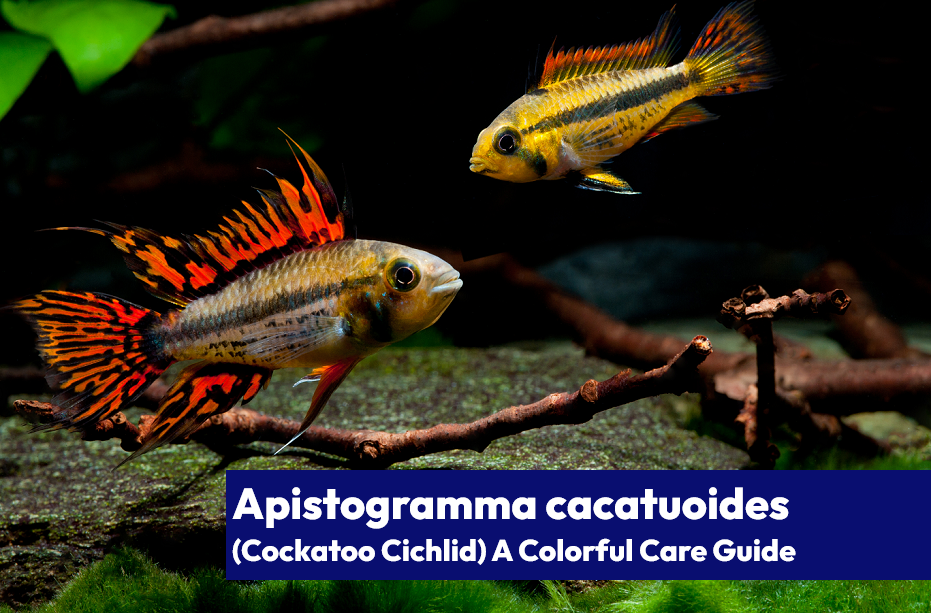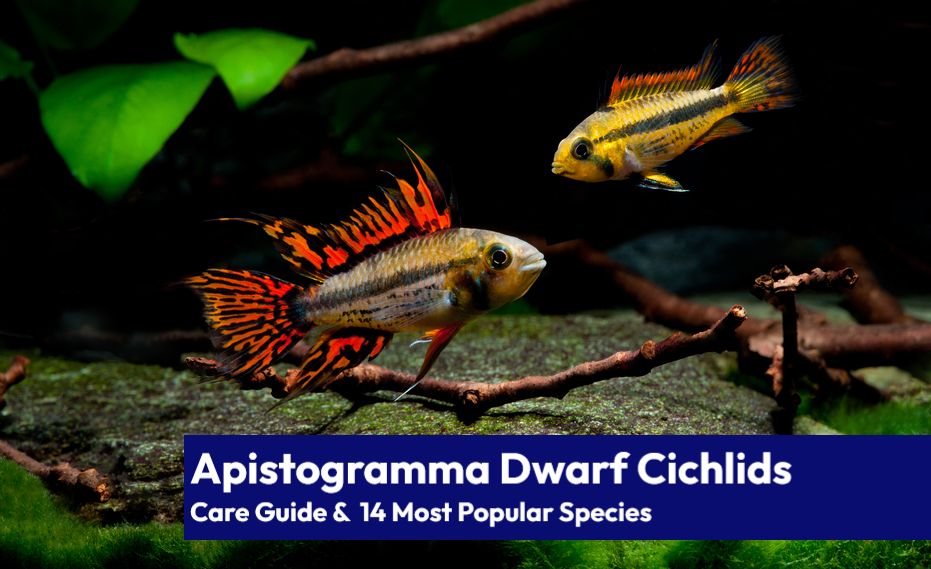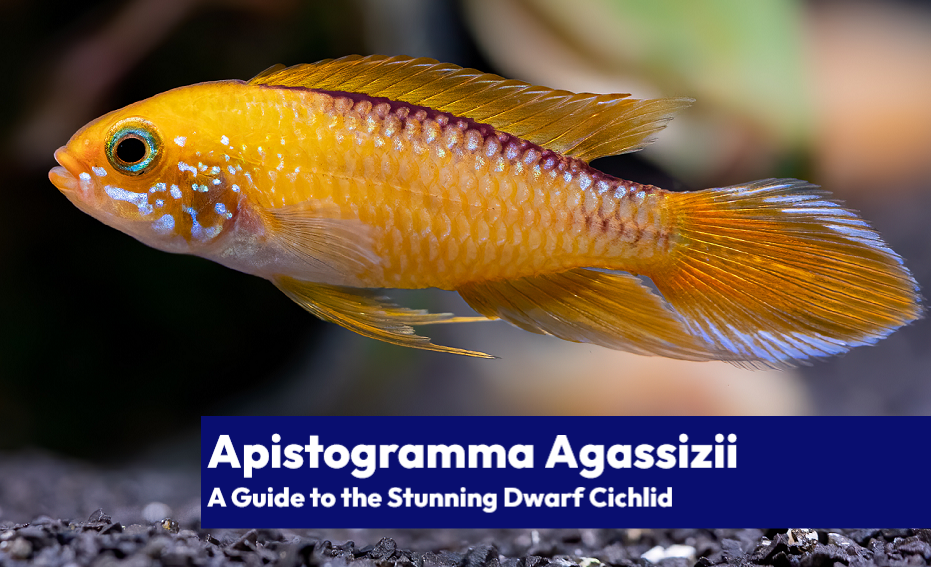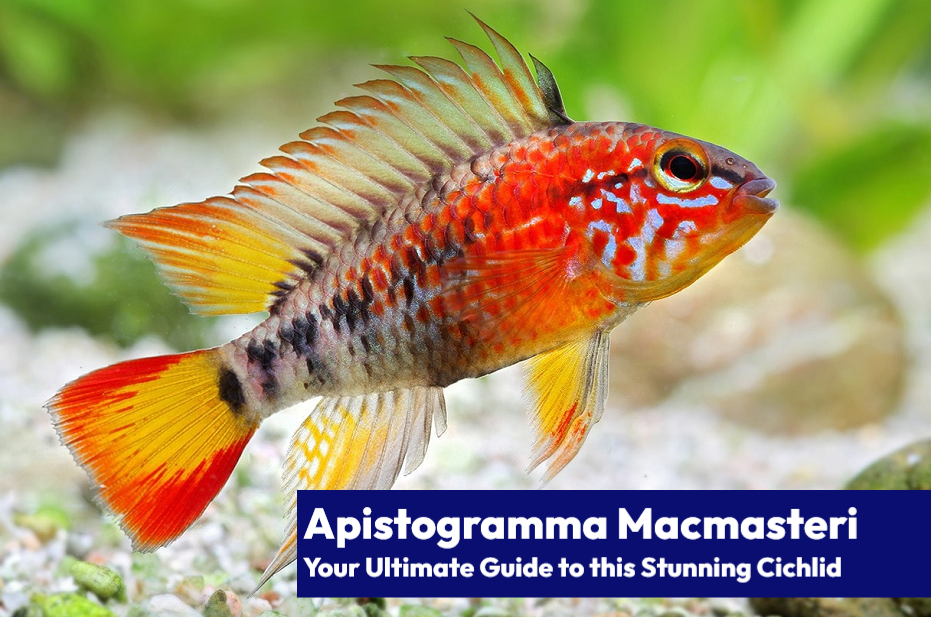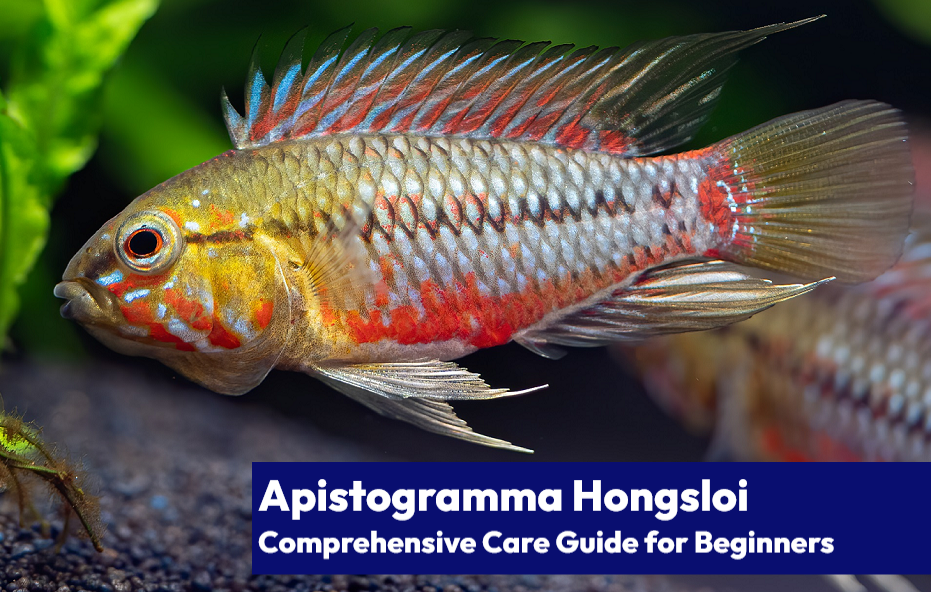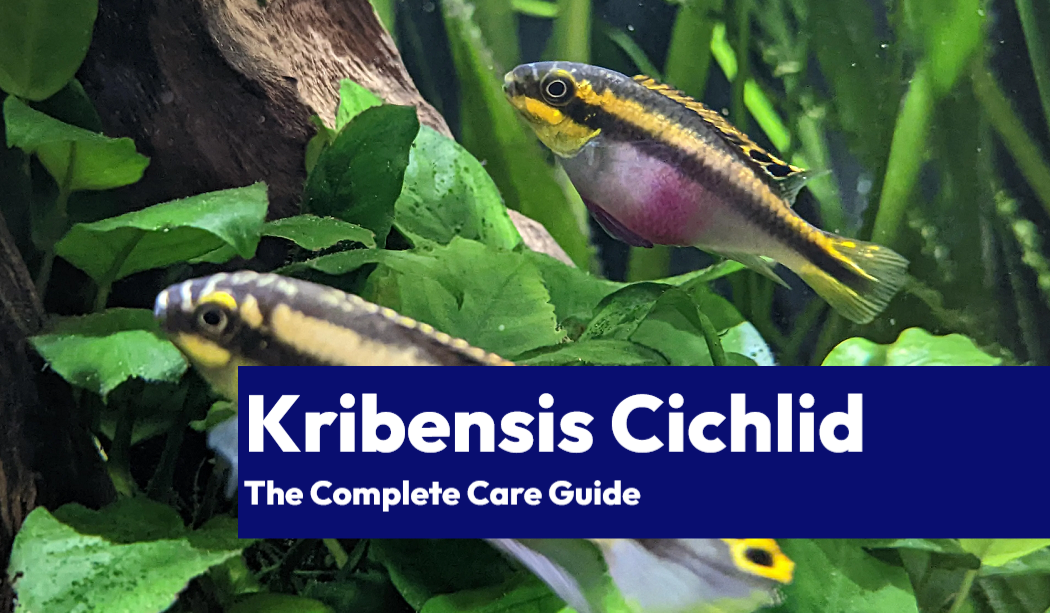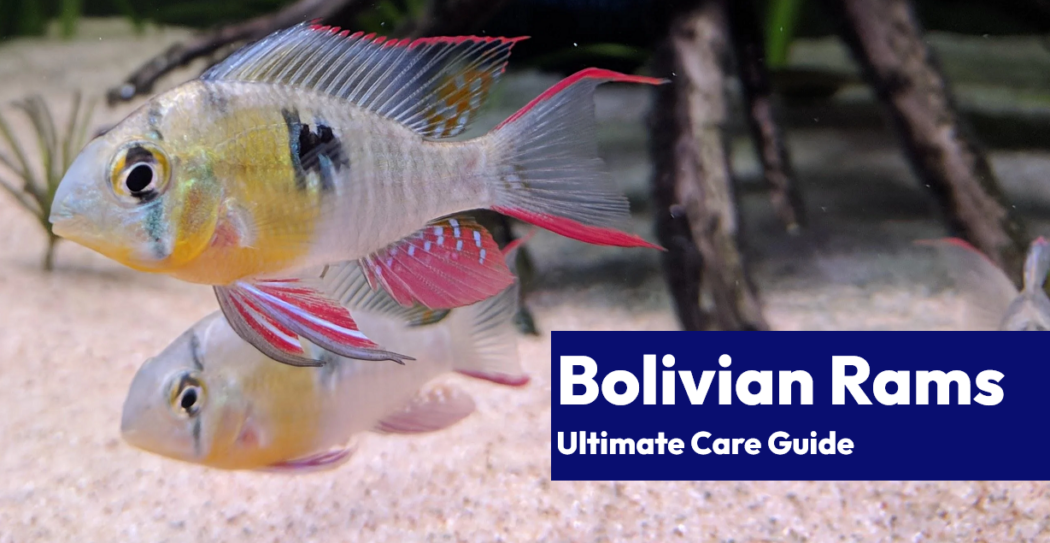Greetings, fish enthusiasts! Today, we’re going to dive deep (pun absolutely intended) into the fascinating world of the Apistogramma cacatuoides, also known as the Cockatoo Dwarf Cichlid. So, buckle up your scuba gear, and let’s explore this charming little fish together! 🤿
The Lowdown on the Cockatoo Dwarf Cichlid (Aka the Cutest Fish You Never Knew You Needed)
Apistogramma cacatuoides are small, colorful cichlids native to South America. With their striking appearance and engaging personalities, these little guys are sure to brighten up any aquarium. But before we go gaga over their good looks, let’s get down to the nitty-gritty of caring for these adorable fishies.
| Care Data | Apistogramma cacatuoides (Cockatoo Dwarf Cichlid) |
|---|---|
| Scientific Name | Apistogramma cacatuoides |
| Type | Freshwater Cichlid |
| Adult Size | 3-3.5 inches (7.5-9 cm) |
| Tank Size | 20 gallons (76 liters) minimum |
| Optimal Temperature | 75-82°F (24-28°C) |
| General Hardness dGH | 3-10 dGH |
| Carbonate Hardness dKH | 1-4 dKH |
| Optimal pH range | 6.0-7.5 |
| Diet Type | Omnivore |
| Feeding Frequency | 2-3 times a day |
| Water Change Frequency | Weekly, 20-30% |
| Can Breed In Captivity? | Yes |
| Number of Fry (if applicable) | 30-100 |
| Spawning Type | Cavity spawner |
| Native Range | South America (Amazon River Basin) |
| Temperament | Peaceful, territorial |
| Schooling/Shoaling Fish | No |
| Known to Jump Out of Tank | No |
| Average Cost (USD) | $10-25 |
That’s One Good-Looking Fish! (But Seriously, How Can I Get One?)

Apistogramma cacatuoides have a striking appearance, with vibrant colors and bold patterns. Males typically sport a bright yellow-orange body with bold black markings, while females are generally a more muted yellow or silver-grey with dark stripes.
As for sexual dimorphism, males are larger and more colorful than females, with elongated dorsal and anal fins. The males’ fins also have a lyre shape, which helps distinguish them from their female counterparts.
💡 Pro Tip: You can easily tell male and female Apistogramma cacatuoides apart by observing their body color and fin shape.
The Inside Scoop on the Cockatoo Dwarf Cichlid Anatomy (It’s More Interesting Than You Think!)
These little fish have a compressed, elongated body shape and a small mouth with a slightly protruding lower jaw. They have one nostril on each side of their head and a pair of laterally positioned eyes, perfect for scanning their surroundings for food or potential mates.
Apistogramma cacatuoides have a continuous dorsal fin composed of two sections – a spiny front part and a soft, more flexible rear part. Their pectoral fins are fan-shaped, and their pelvic fins are elongated, allowing them to navigate their watery homes with ease.
Their anal fin is elongated and positioned opposite the dorsal fin, providing balance and stability while swimming. The caudal fin, or tail fin, is usually rounded or slightly forked and serves as the fish’s main propulsive force.
In addition to their functional anatomy, Apistogramma cacatuoides are also covered in small, cycloid scales that create a shimmering effect when light reflects off them. This stunning visual display is just one more reason why these fish are such a popular choice for aquarium enthusiasts.
💡 Fun Fact: The name “cacatuoides” is derived from the fish’s resemblance to a cockatoo’s crest, with the elongated fins of the males resembling the bird’s distinctive head feathers.
Size Matters: The Deets on Growth and Dimensions
The average adult size of Apistogramma cacatuoides is between 3 and 3.5 inches (7.5-9 cm) in length. Males tend to be larger, while females are slightly smaller.
When it comes to growth rate, Cockatoo Dwarf Cichlids can reach their full size within 9 to 12 months, depending on factors like water quality, diet, and overall health. It’s important to monitor their growth and adjust tank conditions as necessary to ensure these fish thrive.
Time Flies: The Cockatoo Dwarf Cichlid Lifespan
Apistogramma cacatuoides have an average lifespan of 3 to 5 years, although some individuals have been known to live up to 7 years in optimal conditions. Maintaining proper water parameters, offering a varied diet, and providing a stress-free environment can help extend your fish’s lifespan.
Finding the Perfect Home: Tank Size and Setup
While a 20 gallon (76-liter) tank is the minimum size recommended for housing a pair of Apistogramma cacatuoides, a larger 40 gallon (151-liter) tank is ideal for accommodating a small group or community setup with compatible tankmates.
A larger tank allows for the creation of distinct territories, which can reduce aggression and stress in your fish. Plus, it provides more space for swimming, hiding, and exploring, all essential factors for a happy and healthy Cockatoo Dwarf Cichlid.

Water Parameters: Creating the Perfect Aqua Environment
Cockatoo Dwarf Cichlids thrive in soft, slightly acidic water with a pH range of 6.0 to 7.5. The temperature should be kept between 75 and 82°F (24-28°C) to mimic their natural habitat. Maintaining stable water parameters is crucial to the health and well-being of your fish.
The Nitty-Gritty on Equipment: Heating, Filtration, Lighting, and More
To create an ideal environment for your Apistogramma cacatuoides, start by installing a quality heater with a thermostat to maintain a stable temperature. A 100-watt heater is suitable for a 20-gallon tank, while a 150-watt heater would be better suited for a 40-gallon setup.
A sponge filter is a great choice for filtration, as it provides gentle water flow and excellent biological filtration without disturbing the substrate or stressing your fish. Make sure to pair the sponge filter with a suitable air pump to keep the water well-oxygenated.
When it comes to lighting, a full-spectrum LED light with a timer is ideal. This not only simulates a natural day-night cycle but also encourages healthy plant growth. For a 20-gallon tank, a 24-inch (60 cm) LED light would work well, while a 36-inch (90 cm) light is more suitable for a 40-gallon setup.
Additional equipment to consider includes water conditioner or mineralizers to ensure optimal water parameters, and a thermometer for monitoring the water temperature.
Setting the Scene: Habitat Requirements
Apistogramma cacatuoides prefer a sandy substrate, which allows them to sift through the sand and search for food. Additionally, choose a dark-colored substrate to help bring out the vibrant colors of your fish.
Functional décor like driftwood, caves, and rock formations not only add visual appeal to your tank but also provide hiding spots and territories for your fish. Adding leaf litter, such as almond leaves, can also help mimic their natural environment and provide additional hiding spots and foraging areas.
Live plants are a welcome addition to any Cockatoo Dwarf Cichlid tank. Some ideal plant choices include:
- Java Fern (Microsorum pteropus)
- Anubias (Anubias spp.)
- Amazon Sword (Echinodorus amazonicus)
- Cryptocoryne (Cryptocoryne spp.)
- Vallisneria (Vallisneria spp.)
💡 Expert Tip: When choosing plants for your Apistogramma cacatuoides tank, opt for sturdy species that can withstand the occasional nibble or uprooting attempt.
A Balanced Diet: What’s on the Menu?
Apistogramma cacatuoides are omnivores, which means they need a balanced diet of both plant and animal-based foods. A varied diet helps ensure they receive all the necessary nutrients to thrive. Some optimal food items include:
- High-quality pellet or flake food
- Frozen or live brine shrimp
- Frozen or live daphnia
- Frozen or live bloodworms
- Blanched vegetables like spinach and zucchini
- Crushed peas
- Occasional fruit pieces, like ripe banana or apple
Feeding frequency is also important. Offer small meals twice a day to prevent overfeeding and maintain water quality.
Understanding Your Fish: Behavior and Temperament
Apistogramma cacatuoides are generally peaceful fish, but they can be territorial, especially during breeding times. Males may display aggression towards other males and sometimes even females. It’s important to provide enough hiding spots and territories to minimize conflict.
Cockatoo Dwarf Cichlids are known for their fascinating courtship and breeding behaviors. Males will often perform elaborate displays to attract females, flaring their fins and showing off their most vibrant colors. They also have a unique parenting style, with the female guarding the eggs and fry while the male patrols the territory.
💡 Important: Always monitor your fish for signs of aggression or stress, and be prepared to separate individuals if necessary.
Making Friends: Ideal Tankmates and Bad Influences
When selecting tankmates for your Apistogramma cacatuoides, it’s essential to choose peaceful species that won’t outcompete or stress your fish. Some ideal tankmates include:
- Cardinal Tetras (Paracheirodon axelrodi)
- Harlequin Rasboras (Trigonostigma heteromorpha)
- Corydoras Catfish (Corydoras spp.)
- Otocinclus Catfish (Otocinclus spp.) 5. Dwarf Rasboras (Boraras spp.)
- Rummy-nose Tetras (Hemigrammus rhodostomus)
- Cherry Barbs (Puntius titteya)
- Kuhli Loaches (Pangio kuhlii)
- Ember Tetras (Hyphessobrycon amandae)
On the other hand, some tankmates to avoid include:
- Aggressive cichlids
- Large, predatory fish
- Fin-nipping species
- Fast-moving, competitive fish
- Territorial bottom dwellers
💡 Did you know: Apistogramma cacatuoides can be kept in a community tank with similarly-sized and peaceful species, making them an excellent choice for those looking to create a diverse, harmonious aquarium.
The Love Nest: Breeding Your Fish
Breeding Apistogramma cacatuoides is not only possible but also relatively easy in the home aquarium. To encourage breeding, provide a soft, sandy substrate, hiding spots, and caves for the fish to establish territories. It’s also important to maintain stable water parameters and a high-quality diet.
Once the male has attracted a female with his courtship displays, the pair will spawn in a cave or other secluded spot. The female will lay up to 80 eggs, which she’ll guard fiercely. During this time, the male patrols the surrounding area to keep potential threats at bay.
The eggs will hatch in about 3-4 days, and the fry will become free-swimming after another 5-7 days. At this point, the female will shepherd her offspring around the tank to forage for food. Feed the fry with crushed flakes or specialized fry food and introduce them to live foods like baby brine shrimp as they grow.
💡 Pro Tip: Perform regular water changes and maintain stable water parameters to keep your Apistogramma cacatuoides healthy and happy, increasing the likelihood of successful breeding.
In Sickness and in Health: Diseases and Illnesses
Like all fish, Apistogramma cacatuoides can be susceptible to a variety of diseases and illnesses. Some common issues to watch for include:
- Ich (Ichthyophthirius multifiliis)
- Fin rot
- Fungal infections
- Bacterial infections
- Internal parasites
Maintaining stable water parameters, a clean tank, and a nutritious diet can go a long way in preventing these issues. If your fish do become ill, consult with an aquatic veterinarian or specialist for appropriate treatments.
A Trip Down Memory Lane: Origin and Native Range
Apistogramma cacatuoides are native to the Amazon River Basin in Peru and Brazil. They are typically found in slow-moving or stagnant waters, such as backwaters and floodplains, which are densely vegetated and filled with leaf litter.
The World of Apistogramma: Taxonomy
The Apistogramma cacatuoides are part of a fascinating group of dwarf cichlids. Some of their closest relatives in the aquarium hobby include Apistogramma agassizii, Apistogramma borellii, and Apistogramma nijsseni.
| Taxonomic Rank | Apistogramma cacatuoides |
|---|---|
| Kingdom | Animalia |
| Phylum | Chordata |
| Class | Actinopterygii |
| Order | Cichliformes |
| Family | Cichlidae |
| Genus | Apistogramma |
| Species | Apistogramma cacatuoides |
Wrapping Up: The Cacatuoides Conundrum Concluded
So, there you have it, my fellow aquarists! With their striking appearance, engaging behavior, and manageable care requirements, the Apistogramma cacatuoides are undoubtedly a fantastic addition to any peaceful community aquarium. By providing them with the proper environment, diet, and tankmates, you can enjoy their captivating presence for years to come.
Quick TL;DR
- Apistogramma cacatuoides are small, colorful dwarf cichlids with distinct sexual dimorphism
- They grow up to 3.5 inches (8.9 cm) and live for 3-5 years
- A 20-gallon (75 L) tank is recommended for a pair or small group
- Optimal water parameters: 72-82°F (22-28°C), pH 6.0-7.5, dGH 2-12, dKH 1-6
- Provide hiding spots, caves, and live plants in their tank setup
- Feed a varied diet of live, frozen, and high-quality prepared foods
- Compatible with other small, peaceful fish species
- Breeding is possible in the home aquarium with the right conditions
- Watch for common diseases and maintain a clean, stable environment

Tim Priest, a renowned aquarium expert with over 15 years of experience in aquatic gardening and fish education, is dedicated to helping enthusiasts create stunning and thriving aquatic environments. As the founder of LearnTheAquarium.com, Tim shares his wealth of knowledge, passion, and expertise through engaging articles, educational resources, and personalized advice.
Discover the secrets to creating captivating underwater landscapes and maintaining healthy aquatic ecosystems. Join Tim on an exciting journey and let your aquarium adventure begin!
